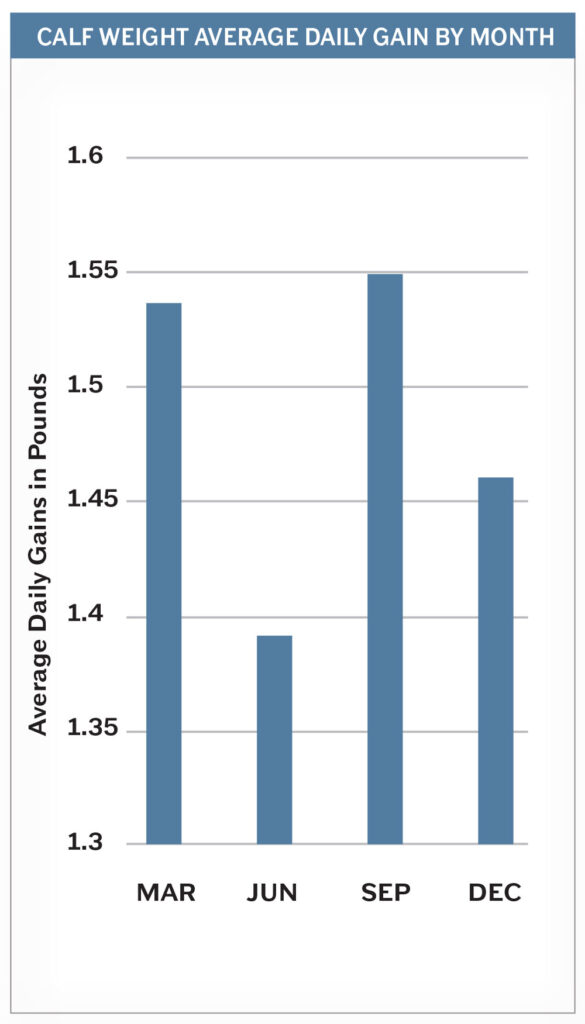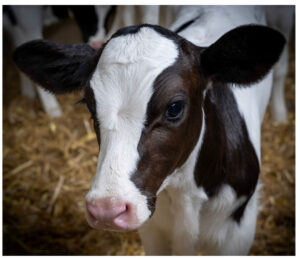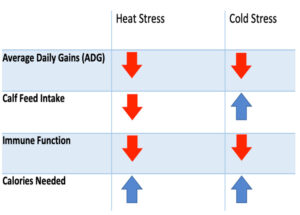How to Identify and Manage Heat Stress in Calves
Click here to view as a pdf: How to Identify and Manage Heat Stress in Calves
 By Cassy Golburg, B.A.
By Cassy Golburg, B.A.
Livestock Specialist
Most livestock producers are familiar with the negative effects of heat stress in lactating cows, but the impact heat stress has on calves and heifers is often overlooked. Heat stress can not only cause a negative impact on calf health but can also cause a negative impact on producer profitability. There are a variety of health issues calves experience from heat stress including dehydration, lower average daily gains, and higher morbidity and mortality rates. A study from Penn State Extension showed that calves exposed to heat stress early in life often had long term ramifications, such as smaller breeding size and an older age at first lactation. These factors ultimately play a large role in decreasing producer profit. Crystal Creek® can help producers evaluate the impact heat stress is having on their calves and determine what steps can be taken to prevent long-term repercussions from it.
Heat Stress Indicators
A one-month-old calf can begin to show signs of heat stress when the air temperature reaches 76° F. High humidity levels can add to further stress. A calf will need to expend more energy to keep cool during times of heat stress, thereby increasing its energy requirements. The first step in managing heat stress in calves is being able to recognize the indicators that a calf is suffering. Common heat stress indicators in calves include:
Decreased feed intake
Increased water consumption
Increased respiration rate
Open-mouth breathing
Increased standing time
Reduced movement/mobility
Effects of Heat Stress
Calves born in the summer often have lower average daily gains when compared to calves born in other months. A recent study conducted in Utah showed that calves born in March and September had the highest daily gains overall. Calves born in summer and winter months had the lowest daily gains. The ADG for calves born in June was lower than that of those born in December, most likely due to the calf’s reduced dry matter/feed intake because of the heat stress they experienced. 
A calf’s energy requirements can increase significantly, up to 20-30%, during periods of heat stress. While this also occurs during winter months, calves born during colder temperatures commonly increase their dry matter intake to compensate for the additional energy demand. However, calves born during warmer months, will often decrease their dry matter intake, leading to a further energy deficit. Energy intended for growth will now go to regulating the animal’s body temperature. If feed intake is decreased, rumen development in the calf will also slow down. This can make it harder for calves to transition after weaning and results in slowing growth in general.
A calf’s immune function can suffer if they are not consuming enough calories on a daily basis. Periods of heat stress will cause calories that were meant for immune system support and development to instead be diverted to regulate body temperature. This reallocation of energy can have a negative effect on the immune system because the calories that would normally be used for immune function, are now being directed for keeping the calf’s body cool. This results in a weakening of the immune system and a chance for opportunistic pathogens to cause illness or disease. A newborn calf may also struggle to absorb colostrum effectively, especially if its dam was also exposed to heat stress. In cases where the calf has reduced passive immunity transfer, the immune system will be weakened even further.
Ways to Alleviate Heat Stress
Meeting the energy requirements of the calf is important whether one is dealing with periods of heat or cold stress. Fitting in an additional feeding, or feeding a larger volume of milk or milk replacer, can help compensate for calories that have been diverted for body temperature regulation due to high environmental temperatures and lower grain intake. Feeding milk three times a day can improve feed efficiency and growth. Offering smaller amounts of calf starter more frequently can also encourage the calf to eat.
Ventilation is key in helping provide a healthy and comfortable environment for the calf. Increasing air speeds during periods of heat stress will help cool the calf. A Penn State Extension study found that calves in properly ventilated calf pens averaged 10-20 less breaths per minute than their non-ventilated counterparts, meaning the ventilated calves were losing less water from their body via respiration. For outdoor hutches, putting a block under the hutch can increase air flow thus lowering bacteria counts and resulting in cleaner air for the calves to breathe. Whether calves are housed in individual hutches or group pens, they should have adequate shade and be able to move out of full sun exposure.
 Fans are another way to help abate heat stress. Fans can help assist in reducing respiration rates and ultimately improve feed efficiency. A study showed that in an environment of 84° F, adding fans increased calf feed efficiency by 21% and increased ADG by 23%. While warm weather air speeds are less strictly guided, experience has shown that airspeeds of 2.25 mph (200 feet per minute) are necessary for providing heat abatement. Fans can also help with the control of fly pressure, but additional fly control measures should always be taken to ensure the fly population is kept to a minimum and not harming calf health and behavior.
Fans are another way to help abate heat stress. Fans can help assist in reducing respiration rates and ultimately improve feed efficiency. A study showed that in an environment of 84° F, adding fans increased calf feed efficiency by 21% and increased ADG by 23%. While warm weather air speeds are less strictly guided, experience has shown that airspeeds of 2.25 mph (200 feet per minute) are necessary for providing heat abatement. Fans can also help with the control of fly pressure, but additional fly control measures should always be taken to ensure the fly population is kept to a minimum and not harming calf health and behavior.
Access to fresh water is vital for healthy animals. A national survey found that the average U.S. farm does not provide calves with access to fresh drinking water until they are 15 days old. Calves should be provided with water at 1-2 days old. Access to free choice, fresh water can improve starter intake as well as help prevent dehydration. Water consumption is critical to rumen development. A calf that has access to water is less likely to scour. Calves who scour and do not have access to water are much more vulnerable to the effects of heat stress. Rinsing water buckets daily, and making sure they are clean and sanitary, can help increase the amount of water a calf drinks in a day.
Practicing good management techniques like handling stressful activities when it is cooler can reduce the impact heat stress has on calves. Performing tasks such as vaccinations, dehorning or transportation during the morning, or cooler times of the day (or avoiding these activities all together if the temperatures are above 80° F), can be very beneficial.
It is important to be aware of how calves experience heat stress and what effect it has on your operation’s bottom line. Crystal Creek® is here to help you develop an effective heat stress management strategy for your calf raising operation. With a little planning, there are many things that can be done to lessen the effects of heat stress on calf health and development and ultimately, on producer profitability.
References available upon request.

